London, Paris and Lisbon 2016
I walked into a convenience store near Lisbon’s main square and heard two shopkeepers speaking Hindustani. I joined in and asked where they were from. “Punjab” is the answer I got, not India, not Pakistan, the two possible countries. “My family is from Punjab too”, I chimed in. “Yeah, you look kind-a Asian”. I asked how they got to Lisbon. “I was in England for some years, but I didn’t like the climate. Here, its much better”. Brexit may require him to get used to British fog and drizzle again.
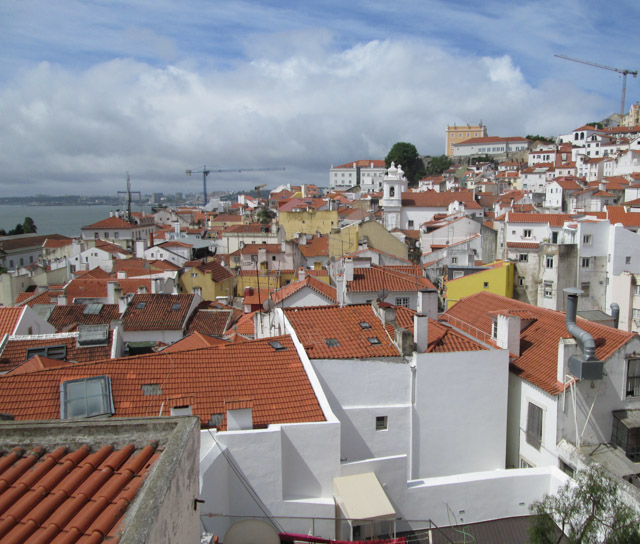
Lisbon
I did expect to see South Asians in Portugal, but from Goa, not Punjab. After India annexed Goa in 1961, Portugal gave the right of citizenship to all of Goa’s citizens born before that date, and for their three succeeding generations. I had a brush with this international incident when I visited Macau in 1970, still under Portuguese rule. The immigration officer examining my Indian passport refused to let me in on the grounds that Portugal and India were at war. I explained that the war happened a decade ago and lasted just a few hours anyway. According to him, the countries were still at war as no peace treaty had been signed. Because he was Chinese, I assumed he had no interest in that conflict, so I asked why it should matter to him if I spent a few hours in Macau? He gave me a stern look and asked an armed soldier to escort me on to the next hovercraft back to Hong Kong.
London
I had just finished a book on Indian history that had been on my mind and in my heart for 40 years. To take a break, I thought to visit friends in London, Paris and Lisbon and some of my favorite art galleries and museums in the first two cities. Although I enjoy living in the San Francisco Bay Area, its theater and museums do not measure up to London, Paris, New York or even Los Angeles. I need to venture out get my fix.
I started my trip in London where most of my European friends live, relationships that began when I was in college almost six decades ago. I was an innocent 18 years old, came from a secluded boarding school in the Himalayas to a metropolis. It was a difficult and prolonged adjustment cushioned by long walks on Hampstead Heath—I lived on the borders of that huge park for most of my stay in London. I return there on every visit. It is my go-to place for introspection. This time, I reflected on the completed project, not entirely happy with the outcome, and on my next project.

Kenwood
The weather was brilliant for my first walk, sunny and warm, drawing crowds to places with views. The flowers around Kenwood, a stately manor at one end of the park, were exploding with color, reaching out to be touched and plucked. I was introduced to a new corner of the heath, the Vale of Health, where two great authors–R. Tagore and D.H. Lawrence–lived for a while. It used to be that Hampstead was the abode for intellectuals and Kensington and Chelsea for bankers and brokers, but apparently the rise in housing prices has shut out intellectuals.
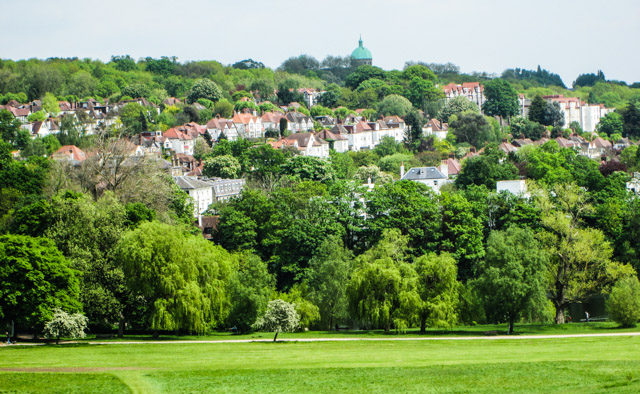
View of Highgate
I walked through most of central London from the Royal Academy to the National Gallery and the British Museum; in Kensington from the Victoria & Albert Museum through Hyde Park to Marble Arch. Those areas of London have not changed since my last visit, but from a ferry-ride along the Thames I noticed new, gleaming high-rises with unusual shapes and names like “The Shard” in the City and further east.
On visits to the British Museum, I lingered at the Amaravati Stupa and Buddhas in the Asia Gallery, the mummies in the Egypt Gallery, and especially the stunning, wall-length bas-reliefs from Assyrian palaces—amazed and humbled as always by the achievements of our ancestors. I walked through special exhibits about ancient globalization: the first, showed Sicily as a mélange of several old Mediterranean and Norman cultures; and the second, presented objects ranging from colossal statues to tiny, intricate jewelry from recently excavated ancient cities of Egypt that were underwater for centuries, where trade helped fuse Egyptian and Greek cultures.
The Tate Modern, my favorite art gallery in London, was under construction, but had two small, special exhibits—“States and Citizens”, showing how artists engage with society, and “Materials and Methods”, presenting artists’ use of diverse materials. Tate Britain exhibited British art from 1500 to the present, a large collection of Turners, and a couple of rooms of Henry Moore’s drawings and sculptures, including the reclining figure and family group, among his best-known work. In the Victoria & Albert Museum, I saw Botticelli’s Venus juxtaposed with other artists’ paintings in that genre, showing his influence on them. I walked through the museum’s South Asia collection, which has some exquisite Moghal miniatures. Nearby, the Science Museum exhibited Leonardo de Vinci’s drawings exploring anatomy, biology and engineering.
London is the Mecca for theater, but on this visit, it just barely earned that distinction. At the National Theater, my friend and I walked out of “Suicide”, a gimmicky, modern production, with background projections and music, which I could not follow, partly because of the actors’ accents, but my friend did, and still did not like the play. Although “Flick” was spoken in American English, hardly anything was said or done–the first act, an hour and forty minutes, had about 5 minutes of conversation. The actors’ nuanced gestures could not overcome the painfully slow pace. I lost patience and left at intermission. The “Taming of the Shrew” at the Globe was enjoyable, but inaudible at times. As our seats were to one side, it was difficult to hear actors when they faced front. “Lawrence after Arabia” at the Hampstead Theater was a solid production and Geraldine James’s performance was terrific. I learned that Bernard Shaw’s family sheltered and supported Lawrence, and his wife Charlotte helped Lawrence complete his book. The best play I saw was “The Curious Incident of the Dog in the Night-Time” with a spare, but attractive modern set, and good performances by all the actors. London’s reputation for great theater was saved.
Paris
I took the Eurostar to Paris for the first time. It’s convenient and comfortable and generally fast, except my train was an hour late. Paris is such a beautiful city, even in the near constant drizzle and rain. I walked to and through two museums per day, absorbing as much art and history as I could in three days. In retrospect, that may have been a mistake as my senses were overwhelmed. It was difficult to retain the fine detail of each great work. Instead, I browsed the galleries with a diffuse appreciation.
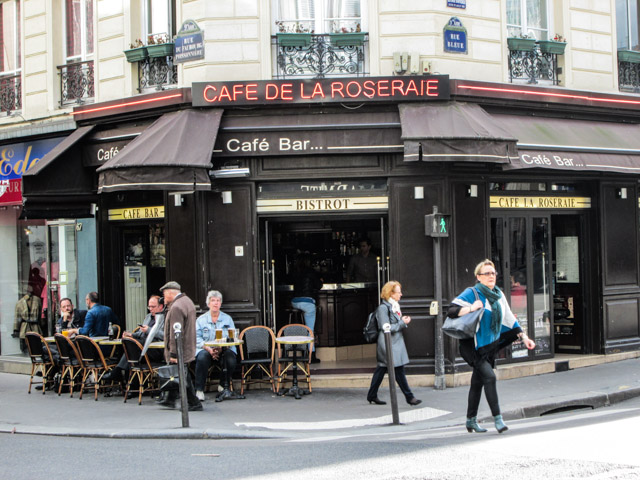
Parisian Cafe
The paintings of all the great Impressionists were displayed in the Orangerie and Musee D’Orsay. I sat in the middle of oval ponds to enjoy Monet’s Water Lilies at the Orangerie, and at the Musee D’Orsay, Toulouse Lautrec’s panels for a café and Rousseau’s The Dream.
At my favorite museum in Paris, the Rodin, I sat and gazed the muscular Thinker displayed in the grounds. Inside, I was surprised to also see paintings by Munch, Renoir and Van Gogh among Rodin’s smaller pieces. I walked through the Picasso Museum, but only a few of his well-known paintings were on exhibit. I sat in the garden, enjoyed the brief sunshine and the sculptures. Both museums have vastly improved their presentation since my last visit.
On my last day, I visited the Louvre, remembering Cole Porter’s song “You’re the top, you’re the Louvre Museum”. As many tourists agreed with that ditty, I had to weave through the crowd to find the Mona Lisa and Venus de Milo. I especially liked the stele engraved with Hammurabi’s Code from 1754 BCE, one of the first written laws. The Pompidou Center had an exhibit of Paul Klee’s paintings, but only a few appealed to me. Its permanent collection of modern art, including works by Picasso of course, but also Kandinsky, Braque, Matisse and others, was more engaging.
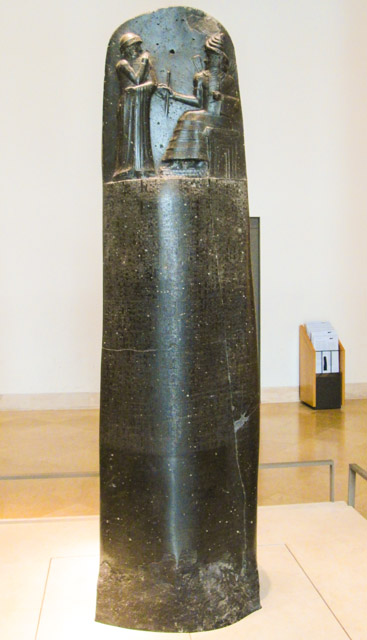
Hammurabi’s Code
Lisbon, Porto, Duoro
I spent two days walking around Lisbon, through the old district (Alfama) with narrow lanes, small patios surrounded by houses, some with decorative tile facades, a reminder of Moorish influence. On the next day, I walked through the modern downtown (Baixa and Chiado), and an area high up on a hill (Bairro Alto) with a view of the city. Rua Augusta, the main street blocked off from traffic, had cafes and restaurants along its center, full of people. Lisbon is a charming city, less rushed than Paris or London.
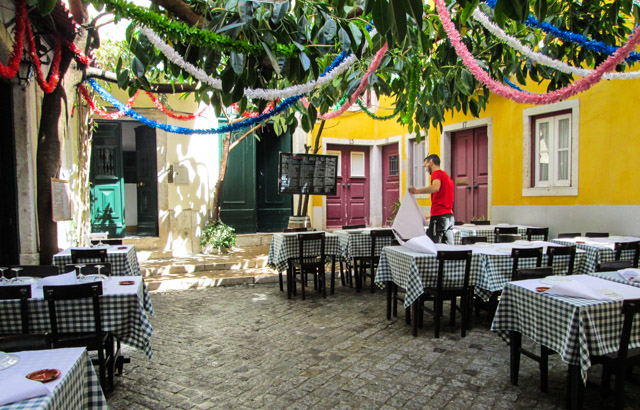
Alfama Cafe
I took a tram ride to the San Jeronimos, a Gothic church and monastery, dedicated to the explorer Vasco De Gama–his sarcophagus was prominent in the church. He visited India in 1498, paving the way for trade and colonization, and died there in 1524.
The Gulbenkian Museum, housing his eclectic, private collection, was the only museum I visited in Lisbon. It had objects, textiles and paintings from early human history to the 20th Century. Some Egyptian and Assyrian pieces and Persian rugs were impressive. Many major artists were represented, such as Rubens, Turner, Rembrandt, Renoir, but not their major works.
I stayed in Estoril with a friend, about 25 km from Lisbon. It’s an upscale suburban town by the beach that sports the Casino Royale of James Bond fame. From there, I walked a couple of miles to Cascais, a resort town with lovely narrow stone paved lanes lined with small shops and cafes and packed with visitors from northern climes. On one afternoon, I drove to Sintra with its Disney-like Pena and National palaces on hilltops that had interesting architecture, but were less impressive inside.

Cascais Beach
After a few days, I drove to Porto, Portugal’s second city with a history dating back to Roman times. It’s a picturesque town along the Duoro estuary, much like Lisbon, but smaller and prettier. The river is lined on one side with brightly painted medieval houses, now café’s and bars, and on the other side, a throng of world-famous Port wineries. In the afternoon I walked through the historic town, with imposing buildings, lovely small squares with cafes, busy shopping streets closed to cars, and over the bridge to the wineries. I sat at Sandeman’s café facing the river, sipping a glass of their 10 Year Tawny, looking at the other bank, the sun brightening the vivid colors of the houses, café’s crowded with young tourists. It’s a UNESCO World Heritage Site for good reasons.
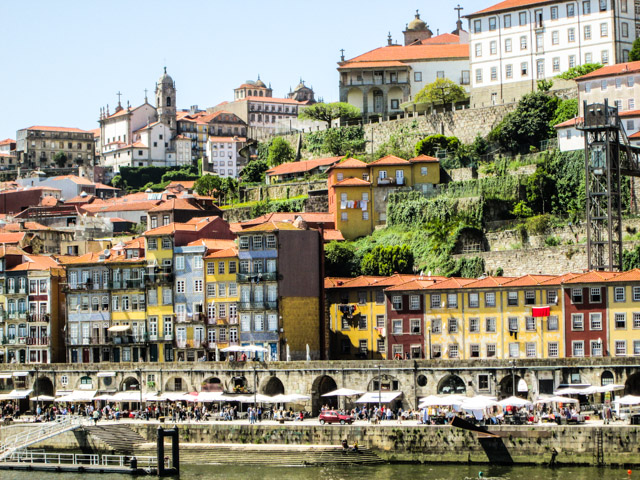
Porto
The next day, I drove along the Duoro River valley, also a UNESCO World Heritage Site, to see its legendary landscapes and taste its Port wines. Neither disappointed. The valley is narrow, with hills rising on both sides planted to grapes and olive trees. I drove up and down the mountains to all the well-known towns with historic centers including Amarante, Villa Real, Peso Da Regua, Pinhao and lodged at a Parador in Alijo. I stopped for meals or coffee or just to walk in the towns, but parking was a challenge as cars have overwhelmed the narrow streets.
The views between towns are truly stunning, folds of hills rising steeply on both sides of the quietly flowing river. But there are no vista points to stop and linger and the small, seriously winding, two-way road up and down the mountains does not allow for distraction. For that reason, its also difficult to reach the wineries as the signage appears too late to make the sharp turn needed to get to them, usually up a steep, winding, rough, stone-paved road.
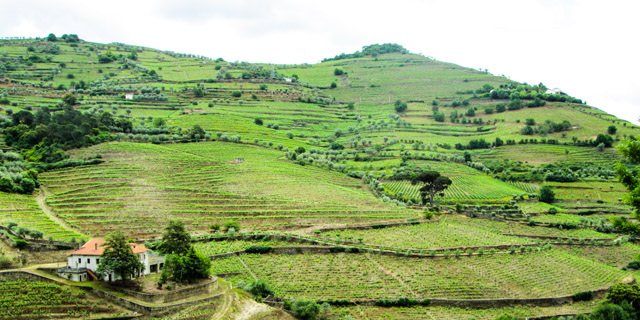
Duoro Valley
Unusually, Quinta do Tedo had visible signage and was easy to reach. It had a parking lot and a well-appointed tasting room with staff that spoke English fluently and offered organized tasting options. I later learned the wife of the couple who own the winery is from Napa in California, not far from where I live. I tasted a flight of their red wines made from estate grown indigenous grapes, full bodied and complex.
With some effort, I managed to find Quinta do Panascal, located up a hill rising above a tributary of the Duoro, its tasting room looking out at the hill on the other side planted to grapes. I had a flight of Ports (blends of many grapes), one dry white, a Tawny (aged in wood barrels) and a Ruby (aged in concrete or stainless steel) accompanied by an informative lesson about the classification. The wines were rich, with voluptuous fruitiness and a dense, velvety texture. They are the jewels in the famous Fonseca family of wineries.
The drive back to Estoril was hazardous because squalls of rain obscured the twisty roads until I reached the highway, and even there the traffic moved cautiously. Highways in Portugal are used sparingly because the tolls are expensive. I stopped in Coimbra, a university that started in the 13th century and settled in the town in the 16th century. Getting a ticket to tour the main quad took longer than the visit. Complicated options were discussed with each visitor. The library was the most interesting, with its long decorated wood tables and chairs, elaborately painted ceiling, and gilded floor to ceiling shelves of books on many disciplines going back centuries. Below the library was a prison for errant academics, which I peeked into hesitantly remembering my past in that profession.
Food
I don’t expect good cuisine when I visit London. But, as all my friends insist, it has improved. I had two nice meals, both in small neighborhood restaurants. At Camden’s Daughter, I had four unusual salads in one plate—pomegranate tabbouleh, fennel radish and apple slaw, baby gem wedges with lemon mint and spring onion and charbroiled eggplant with red peppers, unusual and tasty combinations. At Anima E Cuore, a tiny restaurant with 7 tables, I had a respectable creamy buratta followed by a stone bass, but one of my friends had outstanding seared scallops with two infusions and seafood fettuccini, bursting with seafood in a tangy tomato-based sauce. I do look forward to good cuisine in Paris, but was disappointed. I did not choose well. I had lunch at museums, where I did not expect much, and Tripadvisor recommendations for my three evening meals did not prove memorable, actually one of them was bad enough to be memorable.
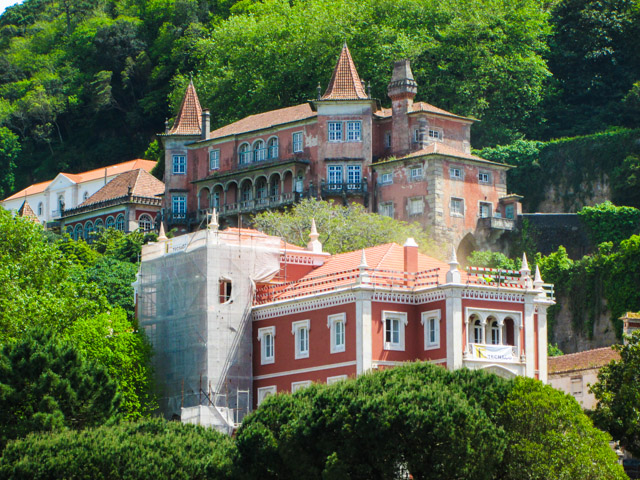
Sintra
Portugal was a new culinary experience. I had no idea what to expect. The best meal was at Marisco na Praca in Cascais, fresh seafood, simply prepared, served with a simple salad and boiled vegetables, a surprising reminder of England in the 1960s. Portugal’s wines are cheap and pretty good. My friend’s house white was a crisp and dry Quinta Do Carmo made from Rupeiro, Arinto and Antao Vaz grapes, and the red wine at the restaurant was Duas Quintas made from Tinta Roriz and Touriga grapes.
Lodging
I lodged with friends for most of my trip and stayed in hotels only in Paris, Porto and the Duoro Valley. The Windsor Hotel Opera in Paris was near the Gare du Nord and bordered by two streets replete with cafes and restaurants offering cuisines of the world. My first look at the room made me feel claustrophobic because it was tiny, but its modern furnishings were comfortable and everything worked. The Infante Sagres in Porto was a splendid old hotel filled with antiques and art. I was given large room with a sitting area, like a small suite, also with antique furniture, but modern facilities. The Parador Forrester, Alijo in the Duoro Valley was fine, but I was disappointed that it was not in the country as the name suggested. It looked like a manor house on the outside, had a pool and tennis court. My room and the common areas were furnished simply in a modern style.
End and Beginning
With perspective from enduring friendships, the stimulus from art, big city diversity and intensity, new places and long walks, I reflected that, although I was not content with the project I finished, it sort-of concluded a long-standing commitment. I felt ready for a new beginning, and decided on a writing project and a working title that may take years to finish. Sounds absurd as I am about to turn 77? Perhaps, but I am following a couple of great authors that I have met briefly, when they were my age. At a conference, I sat at a table for lunch with Gunnar Myrdal, author of seminal books such as An American Dilemma and Asian Drama, and a Nobel Laureate in Economics. Bringing a cigarette to his mouth with trembling hands, wheezing and coughing through lunch, he announced that he had started a lengthy research project. I thought, no way he could finish it, but he did before he died at age 89. A few years later, I attended a seminar led by Erik Erikson in the aftermath of his great book on Gandhi. He continued to publish books until he was about 90 years old.
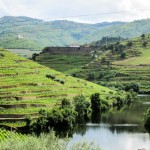

3 Responses to London, Paris and Lisbon 2016